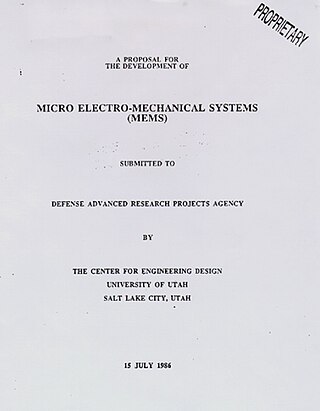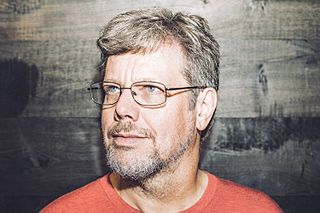Related Research Articles

The Defense Advanced Research Projects Agency (DARPA) is a research and development agency of the United States Department of Defense responsible for the development of emerging technologies for use by the military.

The Internet Engineering Task Force (IETF) is a standards organization for the Internet and is responsible for the technical standards that make up the Internet protocol suite (TCP/IP). It has no formal membership roster or requirements and all its participants are volunteers. Their work is usually funded by employers or other sponsors.

MEMS is the technology of microscopic devices incorporating both electronic and moving parts. MEMS are made up of components between 1 and 100 micrometres in size, and MEMS devices generally range in size from 20 micrometres to a millimetre, although components arranged in arrays can be more than 1000 mm2. They usually consist of a central unit that processes data and several components that interact with the surroundings.
Zope is a family of free and open-source web application servers written in Python, and their associated online community. Zope stands for "Z Object Publishing Environment", and was the first system using the now common object publishing methodology for the Web. Zope has been called a Python killer app, an application that helped put Python in the spotlight.

Guido van Rossum is a Dutch programmer best known as the creator of the Python programming language, for which he was the "benevolent dictator for life" (BDFL) until he stepped down from the position on 12 July 2018. He remained a member of the Python Steering Council through 2019, and withdrew from nominations for the 2020 election.

Robert Elliot Kahn is an American electrical engineer who, along with Vint Cerf, first proposed the Transmission Control Protocol (TCP) and the Internet Protocol (IP), the fundamental communication protocols at the heart of the Internet.

A digital object identifier (DOI) is a persistent identifier or handle used to uniquely identify various objects, standardized by the International Organization for Standardization (ISO). DOIs are an implementation of the Handle System; they also fit within the URI system. They are widely used to identify academic, professional, and government information, such as journal articles, research reports, data sets, and official publications.
A lab-on-a-chip (LOC) is a device that integrates one or several laboratory functions on a single integrated circuit of only millimeters to a few square centimeters to achieve automation and high-throughput screening. LOCs can handle extremely small fluid volumes down to less than pico-liters. Lab-on-a-chip devices are a subset of microelectromechanical systems (MEMS) devices and sometimes called "micro total analysis systems" (μTAS). LOCs may use microfluidics, the physics, manipulation and study of minute amounts of fluids. However, strictly regarded "lab-on-a-chip" indicates generally the scaling of single or multiple lab processes down to chip-format, whereas "μTAS" is dedicated to the integration of the total sequence of lab processes to perform chemical analysis.
Teledyne DALSA is a Canadian company specializing in the design and manufacture of specialized electronic imaging components as well as specialized semiconductor fabrication. Teledyne DALSA is part of the Teledyne Imaging group, the leading-edge imaging companies aligned under the Teledyne umbrella.

Semiconductor Research Corporation (SRC), commonly known as SRC, is a high-technology research consortium active in the semiconductor industry. It is a leading semiconductor research consortium. Todd Younkin is the incumbent president and chief executive officer of the company.
SEMI is an industry association comprising companies involved in the electronics design and manufacturing supply chain. They provide equipment, materials and services for the manufacture of semiconductors, photovoltaic panels, LED and flat panel displays, micro-electromechanical systems (MEMS), printed and flexible electronics, and related micro and nano-technologies.
Microfabrication is the process of fabricating miniature structures of micrometre scales and smaller. Historically, the earliest microfabrication processes were used for integrated circuit fabrication, also known as "semiconductor manufacturing" or "semiconductor device fabrication". In the last two decades microelectromechanical systems (MEMS), microsystems, micromachines and their subfields, microfluidics/lab-on-a-chip, optical MEMS, RF MEMS, PowerMEMS, BioMEMS and their extension into nanoscale have re-used, adapted or extended microfabrication methods. Flat-panel displays and solar cells are also using similar techniques.

Multi-project chip (MPC), and multi-project wafer (MPW) semiconductor manufacturing arrangements allow customers to share tooling and microelectronics wafer fabrication cost between several designs or projects.

A chip scale atomic clock (CSAC) is a compact, low-power atomic clock fabricated using techniques of microelectromechanical systems (MEMS) and incorporating a low-power semiconductor laser as the light source. The first CSAC physics package was demonstrated at the National Institute of Standards and Technology (NIST) in 2003, based on an invention made in 2001. The work was funded by the US Department of Defense's Defense Advanced Research Projects Agency (DARPA) with the goal of developing a microchip-sized atomic clock for use in portable equipment. In military equipment it is expected to provide improved location and battlespace situational awareness for dismounted soldiers when the global positioning system is not available, but many civilian applications are also envisioned. Commercial manufacturing of these atomic clocks began in 2011. The CSAC, the world's smallest atomic clock, is 4 x 3.5 x 1 cm in size, weighs 35 grams, consumes only 115 mW of power, and can keep time to within 100 microseconds per day after several years of operation. A more stable design based on the vibration of rubidium atoms was demonstrated by NIST in 2019. The new design has yet to be commercialized.

The programming language Python was conceived in the late 1980s, and its implementation was started in December 1989 by Guido van Rossum at CWI in the Netherlands as a successor to ABC capable of exception handling and interfacing with the Amoeba operating system. Van Rossum is Python's principal author, and his continuing central role in deciding the direction of Python is reflected in the title given to him by the Python community, Benevolent Dictator for Life (BDFL).. Python was named after the BBC TV show Monty Python's Flying Circus.
The Handle System is the Corporation for National Research Initiatives's proprietary registry assigning persistent identifiers, or handles, to information resources, and for resolving "those handles into the information necessary to locate, access, and otherwise make use of the resources".
Tower Semiconductor Ltd. is an Israeli company that manufactures integrated circuits using specialty process technologies, including SiGe, BiCMOS, Silicon Photonics, SOI, mixed-signal and RFCMOS, CMOS image sensors, non-imaging sensors, power management (BCD), and non-volatile memory (NVM) as well as MEMS capabilities. Tower Semiconductor also owns 51% of TPSCo, an enterprise with Nuvoton Technology Corporation Japan (NTCJ).
In the early twenty-first century; foreign investment, government regulations and incentives promoted growth in the Indian electronics industry. The semiconductor industry, which is its most important and resource-intensive sector, profited from the rapid growth in domestic demand. Many industries, including telecommunications, information technology, automotive, engineering, medical electronics, electricity and solar photovoltaic, defense and aerospace, consumer electronics, and appliances, required semiconductors. However, as of 2015, progress was threatened by the talent gap in the Indian sector, since 65 to 70 percent of the market was dependent on imports.

Kevin J. Hemker is the Alonzo G. Decker Chair and Professor of Mechanical Engineering at Johns Hopkins University and holds joint appointments in the Departments of Materials Science & Engineering and Earth & Planetary Sciences.
References
- ↑ "About CNRI". Corporation for National Research Initiatives. Archived from the original on 23 September 2015. Retrieved 9 November 2015.
- ↑ "Handle.net - General FAQs". Handle.net. Corporation for National Research Initiatives. Archived from the original on 27 August 2015. Retrieved 9 November 2015.
- ↑ Rossum, Guido Van (27 January 2009). "The History of Python: Personal History - part 2, CNRI and beyond". The History of Python. Retrieved 23 September 2017.
- ↑ "Senior Advisory Board Member". Northern Virginia Technology Council. Retrieved 15 Apr 2014.
- ↑ "Board Meeting No. 1 - Minutes | Internet Society". www.internetsociety.org. Archived from the original on 2017-02-04. Retrieved 2017-02-04.
- ↑ dave. "Footnotes to History". netpolicynews.com. Archived from the original on 2017-02-04. Retrieved 2017-02-04.
- ↑ Reid, Calvin (1996). "Bowker, CNRI to develop digital identifier system". Publishers Weekly. No. 243(38) p.15.
- ↑ Simmonds, A.W. (1999). "The digital object identifier (DOI)". Publishing Research Quarterly. No. 15(2), p. 10-13.
- ↑ "Lost something on the Internet? Never again with new Digital Object (DO) Architecture". The ITU Blog. 2014-01-06. Archived from the original on 2017-02-04. Retrieved 2017-02-04.
- ↑ Muvunyi, Steven. "New system to enhance digital management". The New Times Rwanda. Archived from the original on 2017-02-04. Retrieved 2017-02-04.
- ↑ "Digital Object (DO) Repository Software". Archived from the original on 2014-05-17. Retrieved 15 Apr 2014.